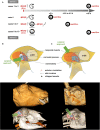Development of a Routinely Applicable Imaging Protocol for Fast and Precise Middle Cerebral Artery Occlusion Assessment and Perfusion Deficit Measure in an Ovine Stroke Model: A Case Study
- PMID: 31798511
- PMCID: PMC6868089
- DOI: 10.3389/fneur.2019.01113
Development of a Routinely Applicable Imaging Protocol for Fast and Precise Middle Cerebral Artery Occlusion Assessment and Perfusion Deficit Measure in an Ovine Stroke Model: A Case Study
Erratum in
-
Corrigendum: Development of a Routinely Applicable Imaging Protocol for Fast and Precise Middle Cerebral Artery Occlusion Assessment and Perfusion Deficit Measure in an Ovine Stroke Model: A Case Study.Front Neurol. 2020 Jan 31;11:46. doi: 10.3389/fneur.2020.00046. eCollection 2020. Front Neurol. 2020. PMID: 32082249 Free PMC article.
Abstract
Temporary middle cerebral artery occlusion (MCAO) in sheep allows modeling of acute large vessel occlusion stroke and subsequent vessel recanalization. However, rapid and precise imaging-based assessment of vessel occlusion and the resulting perfusion deficit during MCAO still represents an experimental challenge. Here, we tested feasibility and suitability of a strategy for MCAO verification and perfusion deficit assessment. We also compared the extent of the initial perfusion deficit and subsequent lesion size for different MCAO durations. The rete mirabile prevents reliable vascular imaging investigation of middle cerebral artery filling status. Hence, computed tomography perfusion imaging was chosen for indirect confirmation of MCAO. Follow-up infarct size evaluation by diffusion-weighted magnetic resonance imaging revealed fluctuating results, with no apparent relationship of lesion size with MCAO at occlusion times below 4 h, potentially related to the variable collateralization of the MCA territory. This underlines the need for intra-ischemic perfusion assessment and future studies focusing on the correlation between perfusion deficit, MCAO duration, and final infarct volume. Temporary MCAO and intra-ischemic perfusion imaging nevertheless has the potential to be applied for the simulation of novel recanalization therapies, particularly those that aim for a fast reperfusion effect in combination with mechanical thrombectomy in a clinically realistic scenario.
Keywords: CT perfusion; DSA; MCAO; brain imaging; cerebral ischemia; reperfusion; sheep stroke model; translational research.
Copyright © 2019 Herrmann, Cattaneo, Eiden, Wieser, Kellner, Maurer, Haberstroh, Mülling, Niesen, Urbach, Boltze, Meckel and Shah.
Figures





Similar articles
-
A surgical model of permanent and transient middle cerebral artery stroke in the sheep.PLoS One. 2012;7(7):e42157. doi: 10.1371/journal.pone.0042157. Epub 2012 Jul 27. PLoS One. 2012. PMID: 22848737 Free PMC article.
-
Corrigendum: Development of a Routinely Applicable Imaging Protocol for Fast and Precise Middle Cerebral Artery Occlusion Assessment and Perfusion Deficit Measure in an Ovine Stroke Model: A Case Study.Front Neurol. 2020 Jan 31;11:46. doi: 10.3389/fneur.2020.00046. eCollection 2020. Front Neurol. 2020. PMID: 32082249 Free PMC article.
-
Trial design and reporting standards for intra-arterial cerebral thrombolysis for acute ischemic stroke.Stroke. 2003 Aug;34(8):e109-37. doi: 10.1161/01.STR.0000082721.62796.09. Epub 2003 Jul 17. Stroke. 2003. PMID: 12869717
-
Extension of therapeutic window in ischemic stroke by selective mismatch imaging.Int J Stroke. 2019 Jun;14(4):351-358. doi: 10.1177/1747493019840936. Epub 2019 Apr 1. Int J Stroke. 2019. PMID: 30935350 Review.
-
Evaluation of MCAO stroke models in normotensive rats: standardized neocortical infarction by the 3VO technique.Exp Neurol. 2003 Aug;182(2):261-74. doi: 10.1016/s0014-4886(03)00116-x. Exp Neurol. 2003. PMID: 12895438 Review.
Cited by
-
Quality and validity of large animal experiments in stroke: A systematic review.J Cereb Blood Flow Metab. 2020 Nov;40(11):2152-2164. doi: 10.1177/0271678X20931062. Epub 2020 Jun 23. J Cereb Blood Flow Metab. 2020. PMID: 32576074 Free PMC article.
-
The Translational Benefits of Sheep as Large Animal Models of Human Neurological Disorders.Front Vet Sci. 2022 Feb 15;9:831838. doi: 10.3389/fvets.2022.831838. eCollection 2022. Front Vet Sci. 2022. PMID: 35242840 Free PMC article. Review.
-
An Optimal Animal Model of Ischemic Stroke Established by Digital Subtraction Angiography-Guided Autologous Thrombi in Cynomolgus Monkeys.Front Neurol. 2022 Apr 25;13:864954. doi: 10.3389/fneur.2022.864954. eCollection 2022. Front Neurol. 2022. PMID: 35547371 Free PMC article.
-
Selective intra-carotid blood cooling in acute ischemic stroke: A safety and feasibility study in an ovine stroke model.J Cereb Blood Flow Metab. 2021 Nov;41(11):3097-3110. doi: 10.1177/0271678X211024952. Epub 2021 Jun 23. J Cereb Blood Flow Metab. 2021. PMID: 34159825 Free PMC article.
-
Comparison of Large Animal Models for Acute Ischemic Stroke: Which Model to Use?Stroke. 2022 Apr;53(4):1411-1422. doi: 10.1161/STROKEAHA.121.036050. Epub 2022 Feb 15. Stroke. 2022. PMID: 35164533 Free PMC article. Review.
References
-
- Herrmann AM, Meckel S, Gounis MJ, Kringe L, Motschall E, Mülling C, et al. . Large animals in neurointerventional research: a systematic review on models, techniques and their application in endovascular procedures for stroke, aneurysms and vascular malformations. J Cereb Blood Flow Metab. (2019) 39:375–94. 10.1177/0271678X19827446 - DOI - PMC - PubMed
LinkOut - more resources
Full Text Sources

